Communicating with your German Shepherd is paramount in building a close dog-owner connection. While sending a message and expecting it to be understood is quite apparent between humans, it can be a bit more complex when communication occurs between humans and dogs. So how do German Shepherds communicate?
German Shepherds communicate using body language coded in visual, acoustic (sound), olfactory (smell), and tactile (touch) signals. Examples of GSD communication can include intense staring, avoidant eyes, forward or backward-tilted ears, a wagging tail, panting, hackles, stance, and pawing.
In this article, I’ll tell you about the German Shepherds’ ability to read and interpret human messages and how they use body language to send messages back to you.
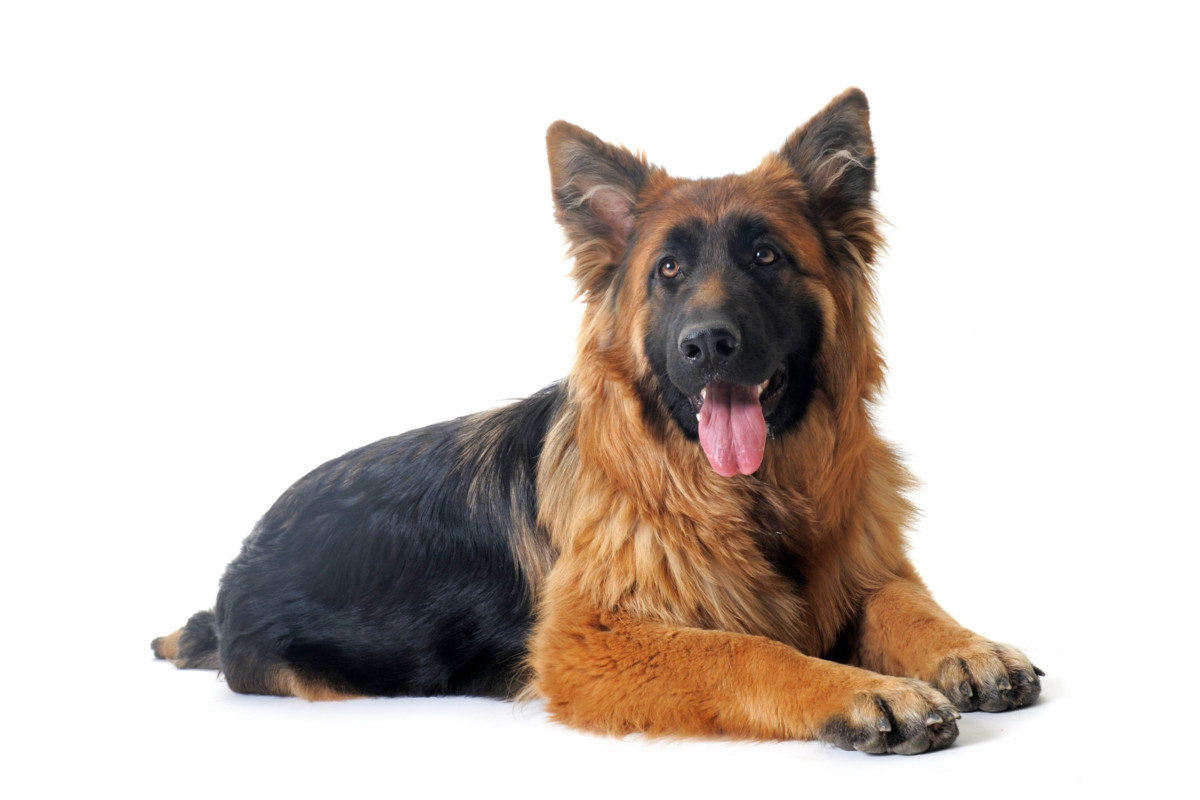
So, let’s investigate the world of German Shepherd communication and how to read your dog’s body language.
Communicating With Your GSD: Facts You Should Know
Because communication is a two-way process, how a German Shepherd Dog communicates often depends on the message received from the other end -and the meaning they have been taught to assign to the message communicated!
Learn How To Communicate With Your Dog In This Video…
As with humans, communication among dogs entails codes that send messages and share meaning with their conspecifics. Following domestication, some of these codes have been maintained while others have changed to fit the human-dog communication context.
To understand how your German Shepherd sends and deciphers communication and how you should code your messages and interpret theirs, you should keep these three facts in mind:
1. Dogs Process Information in a Way Similar to Humans
Research has discovered that a dog’s brain processes information similar to the human brain, thus explaining why German Shepherds (and all dog breeds) understand some human words. Specifically, the left side of a dog’s brain processes the meaning of words, while the right side processes voice intonation.
Therefore, your German Shepherd will integrate the information processed from the two brain hemispheres to make meaning of your communication.
For example, your GSD’s left hemisphere will process your “good boy!” praise, and the right side, the tone with which you say it, causes your dog to communicate happiness using body language. I shall explain this in detail a little later.
2. Dogs Have a Fast Repertoire of Communication Signals
Dogs have a wide range of signals to express themselves among other dogs and with humans.
Visual Signals
Your German Shepherd will use visual communication signals to send messages by modifying parts of their body or exacting control over body muscles to create body postures that are meant to tell you about its feelings and intentions. Some may have changed their original meaning in the dog world to adapt to domestication.
Acoustic Signals
German Shepherds have maintained most of their ancestral wolf vocal signals to communicate and adapted many of them to fit the human social context. For instance, barking sends diverse messages depending on tonality, rhythm, and frequency.
As with visual signals, dogs will use vocalizations to express their emotional states and feelings and fit contexts and owner responses to their acoustic communication. For example, your German Shepherd may learn to use a particular bark every time he needs you to take him for a potty walk if you respond as expected.
Olfactory Signals
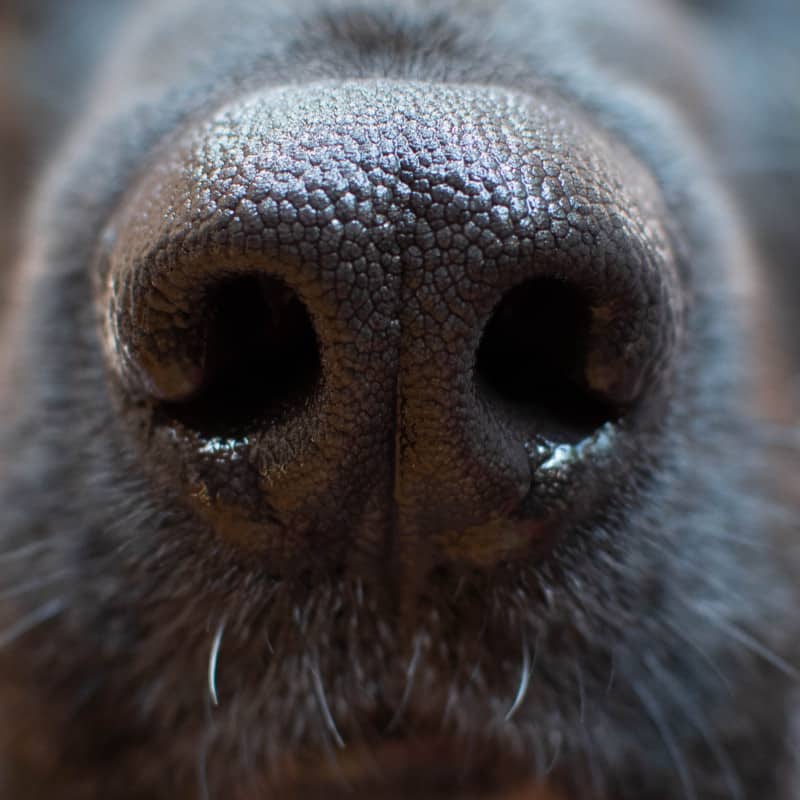
Even though humans don’t give much attention to dogs’ communication using their olfactory capacities, this function is well-pronounced in dogs.
Dog’s sensitivity to odor is at least 10,000 times higher than that of humans.
Their sense of smell allows your German Shepherd to access a lot more human social communication than we would think. For example, if he could, your GSD would tell you what you had for lunch just by licking your face!
Similarly, a German Shepherd may show behavior meant to claim you as their territory just by smelling you and making out that you were in contact with another dog while you were away from them.
Tactile Signals
Tactile communication (touching) in dogs is quite pronounced and is used to communicate various messages. Among dogs, for example, tactile communication is used to express dominance by placing the paws on the back of a subordinate dog or muzzle grabbing.
Placing their head over another dog’s shoulder is a form of greeting or making sexual advances. Similarly, licking another dog’s face is used as grooming or to show dominance, while lying down together shows closeness.
As we shall see later, these tactile signals have maintained their antagonistic or friendship signals even in human-dog communications.
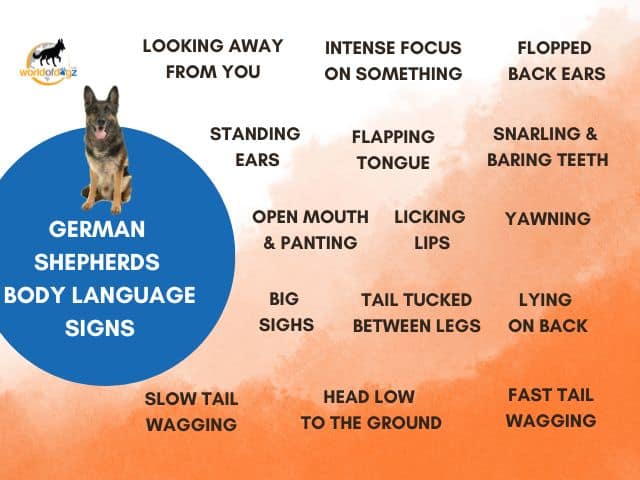
3. Communication Signals to Your GSD Must Have Shared Meaning
Communication is only efficient if the meaning of signals is shared. Training is your chance to let your German Shepherd know what you mean when you make specific commands/signals and understand your German Shepherd’s reaction through his body language.
For example, your German Shepherd may walk away while you are saying, “SIT!” If you have not taught your dog what “sit” means, this cannot be considered disobedience. Your dog simply doesn’t understand you!
Similarly, your GSD may turn his head away from you when you make the “COME” command. In the world of dogs, turning away the head is a sign of disinterest, but that may not be the case if your German Shepherd has not learned that “come” requires him to walk towards you!
Training and socializing your German Shepherd should start early as this helps you understand and communicate with each other. If you’re looking for more comprehensive information on training a GSD, check out this article, How to Train a German Shepherd.
Because body language is a German Shepherd’s primary way of communicating, pairing your verbal signals with visual cues may help achieve better communication training.
Knowing the main ways your German Shepherd will send messages to you and how you can make them understand your messages, we can now proceed to make concrete examples of how German Shepherds use body language to communicate.
German Shepherd Eye Communication
Your German Shepherd will use eye movements to communicate a variety of feelings and emotional statuses.
From a trainer or dog owner’s perspective, it’s also important to make good eye contact with your German Shepherd to get his attention. Here’s a really cool video from celebrity trainer Zak George on how to talk to your dog where he stresses this point. After all, communication is a two-way thing!
Let’s now take a look at the various eye movements your German Shepherd will use to communicate with you:
Intense Staring
Staring can send several messages: danger, begging for attention, or paying attention. You should be able to read the difference between accompanying gestures and the context.
For example, if your German Shepherd is staring at you with shiny half-crossed eyes, he is giving you what some call “begging eyes” and is either asking you to give him some attention or a piece of the tasty chicken that you are munching!
If, instead, your GSD has dilated eyes when staring at another dog or a stranger, it’s time to make a peace pact before hell breaks loose.
During obedience training, your German Shepherd will show you that he is attentive by staring at you, especially if you have taught him related commands like “attention!” or “watch!” or “look at me!” In fact, a study on dogs’ body language and training achievement found that dogs who had wide-open eyes during training showed better learning results.
Squinty and Blinking Eyes
If you are busy working at your computer and your German Shepherd gives you blinking and squinty eyes, he’s sending you a non-verbal signal that he seeks your attention.
But this communication signal can also indicate anxiety if you are in a noisy environment that he doesn’t like. Your GSD will be signaling for you to do something about it, order some calm, or get out of the noisy place!
Dilated Pupils
It’s normal for the pupils of your German Shepherd’s eyes to be dilated when he is in a poorly lighted area or in the dark, just like you and I. But having dilated eyes in broad daylight is a sign of an anxious or stressed dog.
Consider visiting your GSD’s vet if this becomes a consistent signal. Your dog may be having eye problems rather than sending communicative messages.
Darting Eyes
Dashing eyes are signs that your German Shepherd Dog is unsure or skeptical of the safety in the environment. It might be his first walk in an unfamiliar area, and he’s assessing it to make sure there are no threats.
They say dogs can smell danger. In the company of strangers, dogs can tell you who you should trust and who you should not. If your German Shepherd is consistently dashing his eyes and being overly tense while you are talking to strangers, it might be that this is one you should be wary about.
Avoidant Eyes
In the world of dogs, looking straight into another dog’s eyes is a sign of opposition. Instead, lowering their gaze is common in subordinated dogs. Your German Shepherd may avoid looking straight into your eyes to confirm you are the alpha of the pack, especially if that has been made very clear to him.
In most cases, however, your German Shepherd dog’s avoidant eyes are your pet’s version of “I’m not in the mood!” So, if you or another dog or pet is trying to engage your GSD in play and he avoids looking at you, you might as well give up trying for now. He might even get up and go lie down in a distant location if he was lying next to your feet.
In a mating context, a female dog will lie down and avoid the male’s eyes circling her to bluntly send the message, “Keep off!”
The “Half-Moon” Eye
If your German Shepherd’s eyes are to the side opposite where his head is facing, and the whites of the eye are visible (what is known as “half-moon eye” or “whale eye”), he is alert to some noise or movement or is anxious about something happening around him. Your German Shepherd will avert his head slightly, but his eyes will remain fixed on something else.
What Do German Shepherds’ Ear Positions Mean?

As with the eyes, your GSD will use his ears to send different communication messages, often in combination with other body signals.
German Shepherds naturally have pointy ears. However, a dog’s ears can provide many cues to how he is feeling or what he is trying to say.
Let’s look at how your German Shepherd will use his ears to communicate:
Ears Up and Down
This is your German Shepherd’s normal way of greeting you, other humans, or other dogs. It could be accompanied by face-licking and tail-wagging.
Forward-Tilted Ears
Your German Shepherd will use forward-tilted ears to generally communicate focus, alertness, and a sense of confidence. This is often accompanied by a self-assured demeanor.
An earlier quoted research suggests that, in training, forward-tilted ears are associated with attention, confidence, and motivation, and consequently, high dog performance in obedience training.
Backward-Tilted Ears
With his ears tilted backward, your GSD is communicating fear and anxiety. In a training context, for example, this gesture is associated with submission and fear. Somehow, your German Shepherd is sending the message that, even though his eyes are focused on you, the rest of his emotions are directed towards himself in fear and anxiety.
Relaxed and Floppy Ears
Floppy, relaxed ears without any strain are simply signs that your GSD is free of stress and is currently enjoying a relaxed state.
Ears Constantly Tilted in Different Directions
If your German Shepherd is not sure about what they are hearing or where the noise is coming from, he will keep changing his ears’ direction. He may be trying to track a moving animal but has the distraction of moving cars or people talking, making him direct his focus in different directions.
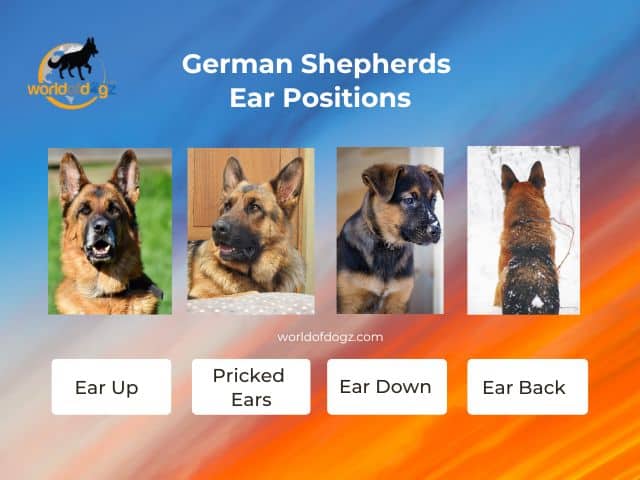
To learn more about ear positions, check this out – German Shepherds Ears Meaning: 4 Examples with Pictures!
What Do German Shepherds’ Tail Positions Mean?
You’ll need to be quite keen to make out your German Shepherd’s messages from his tail, especially if the tail signal is coupled with other communication signals. I have a full article on the meaning of German Shepherd tail positions. However, here are some pointers:
A Wagging Tail
Your GSD is either happy or stressed if he is wagging his tail. You will need to interpret it according to the context. For example, if your dog is eating his favorite food, a wagging tail is a sign of joy. But if that is happening in a noisy and busy shopping mall, then your dog is communicating anxiety.
Earlier referenced research indicates that a non-wagging tail or a tail that wags for a short while and then stops is associated with high performance in training, suggesting that dogs with firm non-wagging tails pay better attention to your commands.
A Low-Hanging Tail
As with the floppy relaxed ears, a low-hanging tail is without any muscle tension, indicating that your GSD is relaxed and calm.
Tail Tucked Between Your Dog’s Legs
Dogs will tuck their tails within their legs when they have been humiliated. You may have noticed that a dog who has just lost a fight with another dog walks away with his tail between his legs. So, this signal is generally bad news; your German Shepherd is communicating that he is afraid, defeated, and uncomfortable.
Tail Carried High
A German Shepherd with his tail carried high can send different messages:
- Your dog is angry about something.
- Your dog is alert and ready to be engaged in play, a fight, or exercise.
- Your dog is sexually excited and is eager to engage with another dog in the vicinity.
In a training context, a tail carried high is associated with close attention and response to obedience commands.
You can learn a lot more about all the German Shepherd tail positions in our YouTube video below…
What Do German Shepherds’ Mouth Positions Mean?
Your German Shepherd can make many mouth and tongue movements. Here are some mouth communication messages and what they mean:
An Open or Closed Mouth
It is hard to read German Shepherd messages from his mouth opening and closing since dogs will naturally open their mouth when active and keep it closed when in a relaxed state. But mouth opening in a relaxed state can indicate both hunger and some form of anxiety. You’ll need to place the action into context to understand your dog’s message.
Panting
Panting is common when your German Shepherd is exercising or has just finished a game of fetch! And while panting is rightly associated with a thermoregulatory function (the release of heat from the body), it can also have other meanings.
Panting can be a sign of fear, stress, and over-excitement. With stress, panting may also be accompanied by drooling.
The shape of your German Shepherd’s tongue also goes with panting. A tongue that just hangs and goes with the panting is characteristic of an active dog out of breath. But a “spatulated” tongue (with the shape of a spatula) indicates an anxious and tense dog.
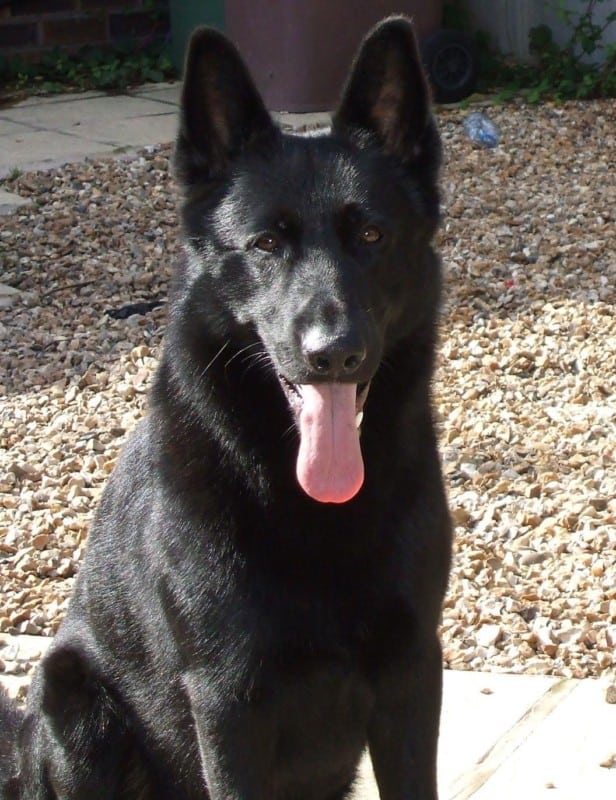
Yawning
As with humans, your German Shepherd may yawn from fatigue, the need to sleep, or boredom. In dogs, yawning may also be linked to stress or opposition with other dogs. Your dog may exaggerate stress-yawning or accompany it with vocalizations.
Licking
Dog licking as a means of communication is associated with affection when directed to the owner or other persons. It can also mean that your German Shepherd is trying to appease and create a connection with you.
However, if your GSD is licking his lips and showing signs of anxiety, he could be asking you to let him rest if you are training or indicating to another dog to simply leave him alone.
Lip-licking with most of the tongue out may also be an instinctual behavior when eating is announced by the noise of feeding bowls or the sight of food.
I have an article, German Shepherd Behavior, where you can learn loads more about crazy dog behaviors.
Communication With Tactile Gestures
Dogs seek physical contact for a calming effect, such as when you stroke the fur behind their ears. To send messages to you using tactile signals, your German Shepherd can use their paws or their entire body to create close contact with you or other dogs and humans.
Leaning on You
When your German Shepherd creates contact by cuddling or seemingly hugging you, it is easy to understand that they are expressing closeness and friendship.
Nonetheless, a GSD that likes sitting on you may not necessarily be communicating friendship. He may be asserting his dominance over you; you belong to him! This may happen, especially if there are other pets in the home that seem to steal your dog’s attention.
Pawing
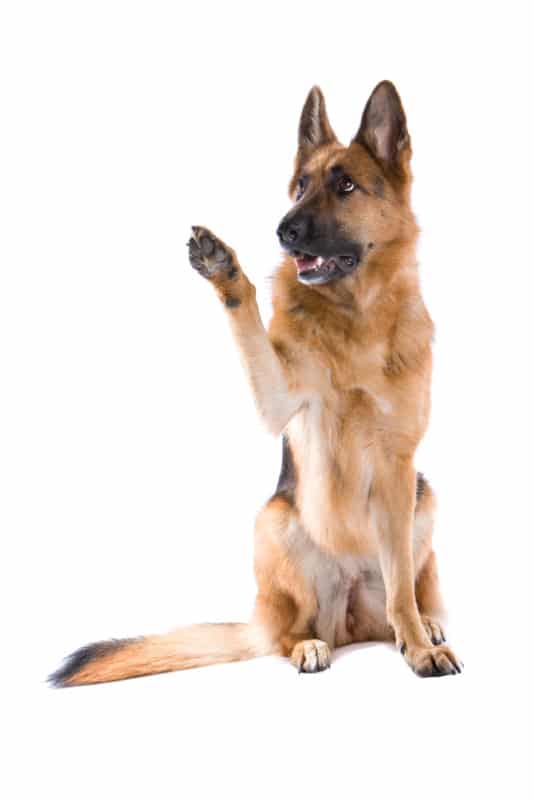
Pawing is a natural way your German Shepherd will try to communicate with you and get your attention.
Dogs will also paw other dogs or the ground when they want to play with them.
Most people will read pawing as a dog giving you his paw in greeting. While that may be true, depending on how you have trained your GSD, pawing has also been associated with attachment experiences in puppyhood.
Puppies will use their paws to direct their mother’s teats to their mouth and express milk. In this light, pawing is read as an attachment behavior carried forward into adulthood in which your German Shepherd will extend its paws to an object of attraction (a caring owner) as opposed to one of resistance (a stranger).
Communication With Fur Movement
The position or state of your German Shepherd’s fur can signal your dog’s emotional status.
Raised Hackles
Piloerection (raised hackles) can indicate aggression, fear, defensiveness, excitement, arousal, or sensed danger. In simple terms, piloerection is an involuntary response that is the equivalent of goosebumps in humans.
The response causes your German Shepherd’s hair on its shoulders and along its spine to stand on end. For a more in-depth article on this subject, go to this post, Why Do German Shepherds Raise Their Hackles?
Extreme Shedding
It’s normal for a German Shepherd to shed abundantly from day to day and more so during fall and spring when they “blow their coat” ready for the new season ahead.
But if your GSD should show extreme shedding in normal seasons, he might be experiencing extreme emotions of fear, anxiety, or stress. Ensure you rule out any medical conditions by visiting your vet.
Read More: German Shepherd Shedding: How Bad Is It, Season & Solutions
Final Thoughts
Communication between humans and dogs makes use of signals used in the dog’s wild ancestry or some that have been modified by the domestication process to suit human-dog communication.
While some of your German Shepherd’s body language may have a clear-cut message of happiness or aggression, others, like pawing, may be hard to decipher, and you may need the wisdom of experts for better interpretation.
The most important point in how German Shepherds communicate is that you should always read your dog’s body language in a context:
- Signal meanings in the dog world
- A combination of signals
- How you have trained your GSD to interpret commands and situations and so their body language responses
- The surrounding environment
- Your German Shepherd’s mental and physical status
This will help you to understand your German Shepherd better so that you don’t end up taking him for another 3-mile hike when all he wanted was a cuddle from you!
Related Posts You May Like:





